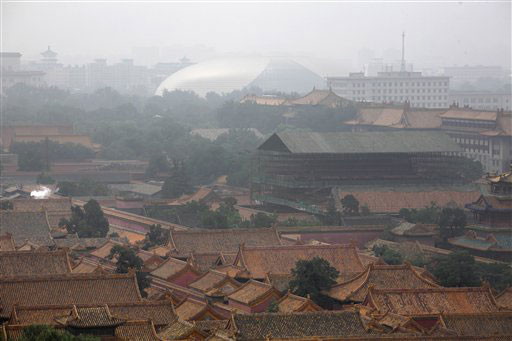The Stranglehold of Weather on Beijing's Air Quality

When the Opening Ceremonies launch the XXIX Olympiad in Beijing on Friday, city officials will no doubt hope their efforts pay off to reduce the city's usual pall of smog and bring blue skies to the games. But their policies may matter little in the face of the region's weather — the main influence on Beijing's pollution levels, according to one scientist. Air pollution in Beijing, and much of the rest of China, has skyrocketed in recent decades, due in large part to a booming economy and rapid industrialization, as well as the nation's huge population, who desire the same amenities as westerners. About 1,000 cars are added to the roads of Beijing alone each year, while China as a whole is commissioning one new coal-burning power plant each week and construction is rampant. After winning the bid in 2001 for this year's Summer Olympics, Beijing pledged to bring down pollution levels in time for the Opening Ceremonies, which will be held on Friday. Since then, the country has been investing in cleaner technologies and improving public transportation and has succeeded in decreasing the levels of some pollutants, such as sulfur dioxide, generated by burning coal. But the scale of the problem has forced officials to also institute more short-term policies to bring down levels of particulate matter (PM), tiny particles suspended in the air and created by factories, coal burning for heat and combustion in vehicles. Beginning on July 20, Beijing officials instituted a ban that took 50 percent of Beijing's cars off the roads and began shutting down hundreds of factories in and around the city. "The efforts they have made to provide good air quality during the Olympics are marvelous," said atmospheric chemist Max Zhang of Cornell University, who is in Beijing studying pollution levels during the two weeks of the Olympics. And in March the International Olympic Committee's Medical Commission announced that it was satisfied with air quality data provided by the Beijing Environmental Protection Bureau. "The IOC is confident that measures already put in place, plus those planned by Beijing organizers and city authorities, will continue to improve the city's air quality leading up to — and during — the Games," a March 17 IOC statement said. But the efforts of the Chinese aren't the only factor — and perhaps not even the most important influence — affecting pollution levels in Beijing. Mother Nature also has a say in the deal: Pollution levels in Beijing depend on whether prevailing winds are blowing in from the heavily industrialized provinces to the south or the more sparsely populated north. The measures Beijing is taking will help, said atmospheric chemist Kenneth Rahn, a retired University of Rhode Island professor, "but, we don’t know how much it's going to add up to, and we don’t know whether that's going to be enough, because of the regionality of the situation." In other words, it all boils down to regional weather, more than local pollutants. Weather patterns Here is why: Winds blowing into Beijing constantly cycle between three main directions: in from the ocean to the east, down from over the sparsely populated desert regions of Mongolia to the north, and up from the heavily industrialized provinces of Heibei, Shanxi and Shandong to the south. As the winds shift, so do the pollution levels in the city. "This is the big story of Beijing's air pollution that is not widely recognized, is that it's always going up and down in regular cycles," Rahn told LiveScience. Rahn has been monitoring these cycles in the run-up to the Olympics and maintains a graph on his Web site showing the shifts in PM levels as reported daily by the Beijing Environmental Protection Bureau. PM levels are reported as the Air Pollution Index (API). The critical API value is 100; below that air is considered "good" or healthy, and above it, air is deemed polluted and unhealthy. On Rahn's graph, huge shifts in API (and therefore PM levels) occur every few days, as a result of the shifts in the wind direction, he explained. Around the day the car ban went into effect, pollution levels were well below 100, but climbed again into the unhealthy range for three or four days before plummeting once again. 'Just a meteorological effect' While Chinese officials attributed the decrease to the effectiveness of their controls, Rahn said "it's just a meteorological effect." He added that the same cycles were seen last August when officials conducted a test ban on vehicles. Zhang said that these measures had brought vehicle emissions down to the levels seen in the United States and Europe, but Rahn said they mattered little in terms of air quality. "There was no detectable change in air quality, at least for the particulate matter, which is the number one concern," Rahn said. Rahn expects pollution levels to rise again as winds shift around and come in from over the industrial southern provinces. "When the air comes from that direction, you are guaranteed high levels of pollution," Rahn said. Bad news for air quality this week In fact, Rahn's graph shows PM levels climbing upward again this week, as the Opening Ceremony approaches. While pollution measures also apply to the provinces surrounding Beijing, Rahn said that enforcement was difficult and that not all factories and pollution sources would be shut down. Even with the car ban and some factories being shuttered, emissions will continue at some roughly steady level. "The emissions in Beijing and the surrounding provinces are exactly the same every day; so all those changes that you see [on the graph] are the effect of weather patterns. Weather patterns rule in Beijing," Rahn said. 'Fighting with meteorology' Zhang agreed, noting that Chinese officials "are now fighting with meteorology, which has not been very cooperative in the end of July." The mountains that surround Beijing on three sides hold the pollutants in over the city, he added. The air in the summer is stagnant over the city, allowing pollution levels to build up, even when emissions were low, he said. "It would be much better off if the Olympics were held in September!" Zhang told LiveScience in an e-mail. Rahn says that the shift of cycles could bring cleaner air back to Beijing during the games, but that it all depends on developing weather patterns. But clean air in Beijing isn't necessarily the same as clean air in the richer countries of Europe and the United States, he noted. China's conundrum Air that met the "healthy" criteria in Beijing would still be considered "unhealthy" in any U.S. city, where the pollution limit can be as much as five times lower than in Beijing. "The dividing line between healthy and unhealthy is a few times higher in China than it is in the United States — for a good reason," Rahn said. "China is a developing country and they cannot force down the throats of the provinces a standard that nobody can meet." Because developing countries lack the capital and technology that more developed countries have to deal with problems of pollution, it is harder for them to make significant reductions, Rahn said. This is the reason that the World Health Organization set "interim" targets for developing countries, to "encourage gradual reduction," said the WHO's Regional Advisor for Air Quality and Health Michal Krzyzanowski. "They're like milestones," he added, used in place of bigger goals that would seem "so remote and so hopelessly far away." When the Olympics end with the Closing Ceremonies in two weeks and the bans in Beijing are lifted, the Chinese will have to go back to slowly chipping away at their pollution problem, regardless of the weather.
- Quiz: Test Your Olympic Knowledge
- The Olympics: History, Controversy and Just Plain Strange
- What Do the Olympic Rings Symbolize?
Get the world’s most fascinating discoveries delivered straight to your inbox.

Andrea Thompson is an associate editor at Scientific American, where she covers sustainability, energy and the environment. Prior to that, she was a senior writer covering climate science at Climate Central and a reporter and editor at Live Science, where she primarily covered Earth science and the environment. She holds a graduate degree in science health and environmental reporting from New York University, as well as a bachelor of science and and masters of science in atmospheric chemistry from the Georgia Institute of Technology.


